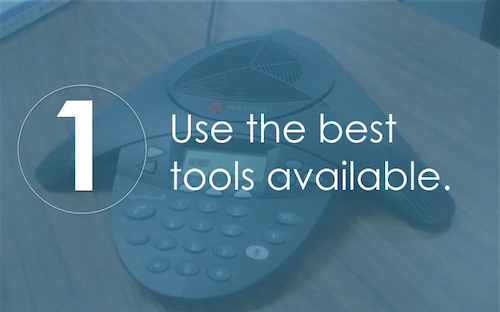Holding meetings is an art and a science. But with remote meetings, it's art and science at a whole new level.
Sometimes the remote factor makes meetings annoying, awkward, inconvenient, and downright infuriating.
Why are remote meetings so unwieldy? It's hard to say, but it could be lack of awareness, faulty software, sluggish Internet connections, and tuned-out participants. Maybe we remote workers just hate meetings.
Whatever the case, remote meetings have a tendency to degenerate into an unproductive waste of time.
Thankfully, it doesn't need to be this way. Here's what you need to know about holding a successful remote meeting.
1. Use the best software available.
A remote meeting is only as good as your tools. When it comes to selecting the best teleconference software or systems, don't skimp.
Find a system that everyone is mostly comfortable with and stick with it. I recommend using one that provides easy screen sharing and video capabilities.
- Skype
- Join.me
- Google Hangouts
Realize that no system is completely error-free. You're going to deal with low quality at some point.
2. Create an agenda and email it to everyone beforehand.
Following an agenda is a crucial part of a successful remote meeting.
Real life meetings depend on agendas, too, of course, but in a remote environment, it's even more important to follow a clear guide.
If call quality is compromised or callers drop from the call, an agenda makes it easy for them to pick back up and jump in the meeting.
It sounds rigid and authoritarian to have rules governing your meeting.
I get that, but at the same time, a lack of structure could send the meeting careening off the rails.
This simple rule -- identify yourself when you start speaking -- can turn a haphazard meeting into a smooth conversation.
Here's why. That brief prefix, "This is so-and-so" serves as a buffer between the telephonic pauses and weird delays of remote meetings.
Some software eliminates the need for introductions by displaying the name or automatically switching to a video image of the speaker In this case, you probably don't need to identify yourself.
Otherwise, ask that each meeting participate introduce themselves -- "this is Daniel" -- before they wax eloquent on their given subject.
4. Have a clear leader.
The meeting needs to have a clear leader. Sorry, but democratized meetings often end up in a free-for-all of confusion and chaos.
The meeting moderator doesn't need to do all the talking, but she should navigate those tricky transitions and guide the discussion.
5. Give everyone a chance to talk.
As in any meeting, there are usually some people who will slip into silence. If you're not using video software, you may not even know whether or not they are still present.
If you ask everyone to participate in a clear and concrete way, your meeting will be more vibrant, more interactive, and hopefully a lot more effective.
According to Inc., in meetings consisting six to eight people, only three people do 70% of the talking. Vocal people tend to speak more, pushing the less assertive participants into the fringes of the meeting.
One technique for involving everyone is to have each team member state in one or two sentences what they are working on for the week.
When everyone talks, everyone wins.
6. Limit participants.
- More background noise
- More distraction
- Lengthier time commitment due to more involvement
- Increased possibility of a poor connection or drop-offs
7. Direct your questions towards specific people.
Open questions that anyone can answer are usually non-starts.
"Anybody have an idea?" is a cue for nobody to chime in.
Why? Because the spontaneity, chemistry, and nonverbal cues of an in-person meeting aren't there. If you speak up, you risk cutting someone off, or missing out on what someone else is saying.
When you ask questions in the meeting, direct those questions towards an individual participant.
8. Don't try brainstorming sessions.
I've never attended a remote "brainstorming" session that was successful.
I'm not saying it's impossible. I'm just saying it's hard.
A Yale study attempted to determine the effectiveness of group brainstorming as a problem-solving technique. They tested individuals brainstorming by themselves vs. groups brainstorming together. Here's what they found.
The solo brainstormers came up with roughly twice as many solutions as the brainstorming groups. A panel of judges deemed their solutions more "feasible" and "effective."
Obviously, this doesn't mean that group brainstorming is useless or unnecessary. It simply means that if you want to engage in brainstorming in a remote meeting, your best solution may be to have team members brainstorm by themselves, and then present their solutions during the meeting.
The electric energy and inspiration that crackles in an in-person brainstorming session is simply not going to be present across the backlit LED displays of a remote meeting.
Here's the conclusion.
Business strategist John Spence makes a great point. He writes, "nearly all of the rules for a typical face-to-face meeting still apply" to remote meetings.
In order to have a good remote meeting, you should also know how to hold a good normal meeting. Yes, you're running a remote meeting, but that doesn't require radical rewriting of all meeting rules.
Follow your best judgment, keep these suggestions in mind, and you'll soon be experiencing the best remote meetings ever.
Have you found these tips helpful? Share this article with your remote team, and see how things improve!









